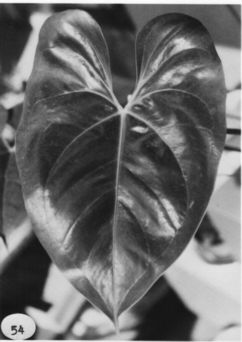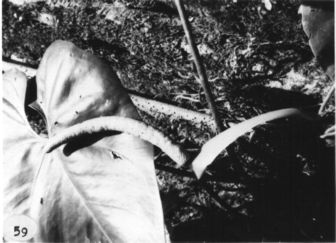






Anthurium curvispadix Croat, sp. nov.
TYPE:Panama. Col—n: Santa Rita Ridge Road, along trail at end of road that goes to Río Indio, beginning 10.6 km from Transisthmian Hwy., 3 km beyond hydrographic station, ca. 380 m, Croat 34294 (MO 2399525, holotype; PMA, SEL, US, isotypes; Live at MO).
Planta epiphytica; cataphyllum subcoriaceum, per-sistens intactum; petiolus teres, 13-59 cm longus; lamina ovato-triangulata ad late ovata, subcoriacea, illae plantarum amplas bullatae, basi cordata, 18-61 cm longa, 12÷40 cm lata; inflorescentia erecta-effusa; pedunculus leres, 21-64 cm longus; spatha subcoriacea, pallide albido-viridis, lanceolata; spadix cremeus, 11-18 cm longus; baccae basi albae, apice pallide viridis, ca. 7 mm longae.
Epiphyte; stems 5-10 cm long, ca. 3 cm diam.; leaf scars 2-2.3 cm wide; roots numerous, green, medium thick; cataphylls subcoriaceous, 11-18 cm long, rounded to obtuse at apex (the acumen apiculate to 6 mm), drying brown (B & K Yellow 4/2.5), persisting intact.
LEAVES erect-spreading; petioles 13-59 cm long, 0.6-1 cm diam., terete; geniculum 2-6 cm long, sometimes weakly sulcate; blades ovate-triangular to broadly ovate, subcoriaceous, becoming bullate in larger plants, gradually long-acuminate to abruptly long-acuminate at apex, prominently lobed at base,
18-61 cm long, 12-40 cm wide; broadest at point of petiole attachment or below; anterior lobe 14÷ 40 cm long, the margins convex, the posterior lobes 7-21 cm long (from apex of sinus to outermost point); sinus hippocrepiform: acute at apex; upper surface semiglossy with numerous-conspicuous raphide cells; lower surface matte to semiglossy; midrib convexly raised above. nan-owing and weakly sunken toward apex. convexly raised below; basal veins 4÷9 pairs, the first, sometimes second, free to base, those remaining coalesced 1.2-4.5 cm, raised above and below, flat or weakly sunken toward margin: posterior rib naked, the outer margin turned up: primary lateral veins 3-8 per side, departing midrib at 35-65° angle, straight to weakly arching near collective vein, flat above, prominulous below; lesser veins obscure above, visible and flat below, more prominent in larger blades; collective vein arising from the first basal vein. loop-connecting the primary lateral veins, flat to weakly sunken above, prominulous below, 5-16 mm from the margin.
INFLORESCENCE erect-spreading; shorter to longer than leaves; peduncle 21-64 cm long, 8-15 mm diam., terete; spathe subcoriaceous, pale whitish green (B & K Yellow-green 8/10-9/10), lanceolate, 13-24cmlong, 1.5-4 cm wide, broadest just above base, long-acuminate at apex, obtuse to acute at base, inserted at ca. 70° angle on peduncle; spadix cream-colored, 11-28 cm long, 8-15 mm diam. at base. 5-11 mm diam. at apex, tapered toward apex:
flowers 4-lobed, 2.3-2.8 mm in both directions. the sides straight to sigmoid, 8-9 flowers visible in the principal spiral, 9-12 flowers visible in the alternate spiral; tepals matte, densely and minutely papillate, lateral tepals 1-1.6 mm wide. the inner margin more or less straight to broadly rounded; pistils white, emergent; stigma ellipsoid ca. 0.3 mm long, raised, brush-like; stamens emerging from the base, laterals emerging neariy to apex before alternates emerge, sometimes the laterals emerging in a scattered manner throughout spadix; anthers creamy white, held at edge of tepals against emergent pistil, 0.4-0.5 mm long. ca. 0.7 mm wide; thecae ovate, moderately divaricate; pollen white, dispersing over tepals.
INFRUCTESCENCE pendent; berries white at base. pale green at apex; ca. 7 mm long; seeds 1÷2, oblong-elliptic, ca. 5-6 mm long. Figs. 54, 57, and 59.
Anthurium curvispadix is known from Veraguas, Code, Col—n, Panama, and Darien Provinces in Panama, from 25 m in Col—n along the Río Guanche to 1,300 m in Veraguas north of Sante Fe. It is found in tropical wet, premontane rain, and lower montane rain forest life zones.
The species is a member of section Calomystrium and is distinguished by its broadly ovate to ovate-triangular blades, its long, tapered, generally curved, creamy white spadix, and its moderately thick, pale whitish green, recurved spathe. Anthurium curvispadix could be confused with A. hoffmannii, but that species, which occurs in Panama only in Chiriquí, has a much shorter, less tapered spadix.
The material represented here may ultimately prove to be two species as one living collection (Croat 33966, included in this description) consistently flowers with a very distinct pleasant aroma from mid-morning to mid-aftemoon that lasts for up to a week, whereas other living collections studied had no obvious aroma. In one case, Croat 34294, a faint rose-like aroma was present.
Two collections, Liesner 1212 and Hammel 4755, differ in having a second collective vein arising from the second basal vein and extending to the apex.
 |
 |
 |
Map of Mesoamerican specimens with coordinates
Panama CoclŽ:, 1978, Folsom (Cult) 3252 (MO, PMA, US).
Panama CoclŽ: 900-1000 m, 8.37N 80.08W, 13 July 1987, Thomas B. Croat
67222 (MO). Panama CoclŽ: 710-800 m, 89.39N 80.36W, 22 June 1988, Thomas
B. Croat 68701 (MO).
Panama Col—n:, 22 March 1976, Thomas B. Croat 33654 (MO).
Panama San Blas: 350 m, 9.19N 78.55W, 11 February 1985, Greg de Nevers
& David Cavagnaro 4836 (MO).
Panama Veraguas: 1300 m, 8.32N 81.07W, 8-9 Sept. 1982, Clem Hamilton,
W. G. D'Arcy & D. Roubik 1246 (MO).